This document discusses a new enhanced method for nonparametric power spectrum estimation called iterative adaptive approach (IAA), which is designed to improve spectral analysis of non-uniformly sampled data sequences. It compares existing methods such as the Fourier periodogram, least squares periodogram (LSP), Welch, MUSIC, and ESPRIT, highlighting the limitations of traditional methods and demonstrating the advantages of IAA in terms of accuracy and computational efficiency. Additionally, it presents a framework for designing optimal sampling patterns based on prior spectral estimates to minimize errors in future measurements.
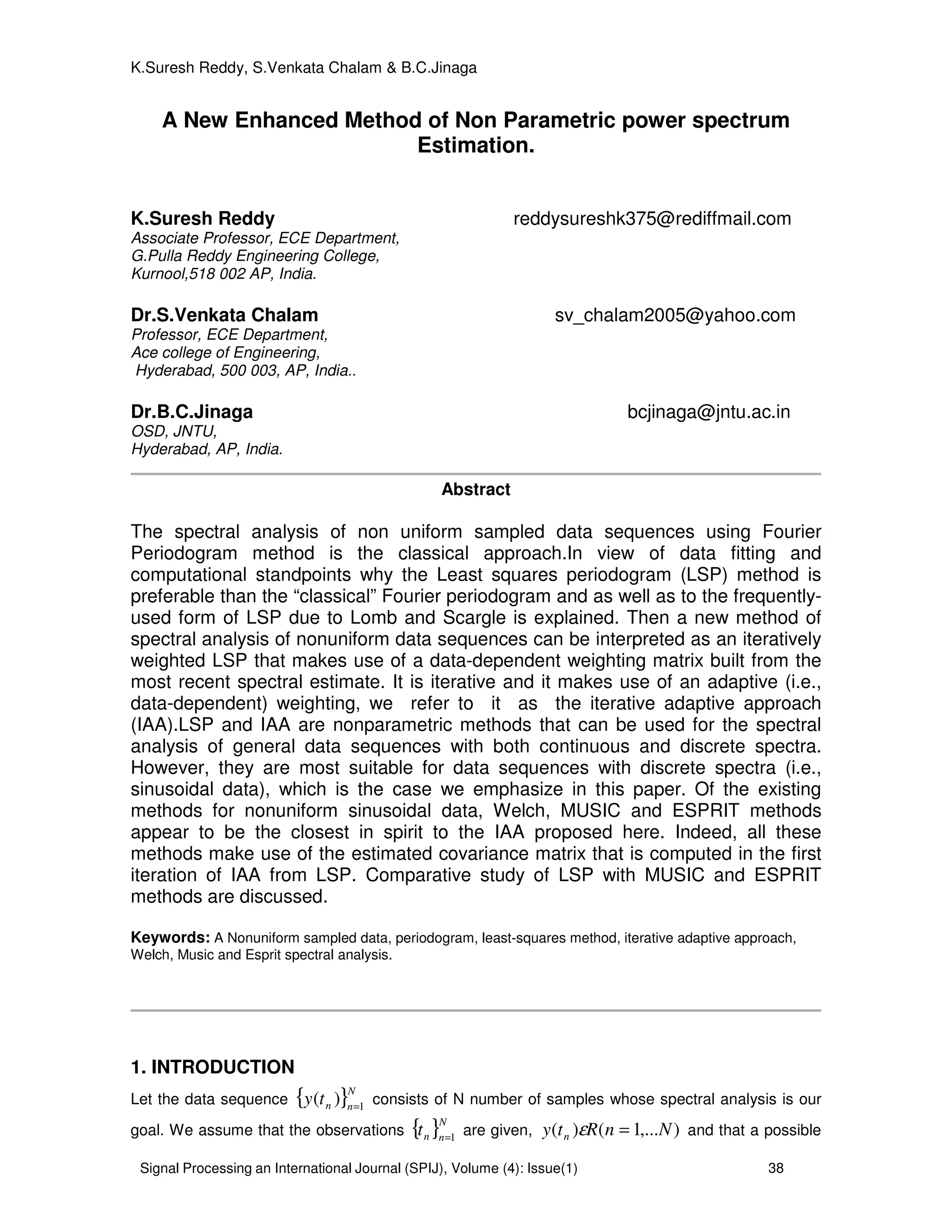
![Signal Processing an International Journal (SPIJ), Volume (4): Issue(1) 39
K.Suresh Reddy, S.Venkata Chalam & B.C.Jinaga
nonzero mean has been removed from{ }N
nnty 1
)( =
, so that
∑=
=
N
n
nty
1
0)( . We will also assume
throughout this paper that the data sequence consists of a finite number of sinusoidal components
and of noise, which is a case of interest in many applications. Note that, while this assumption is not
strictly necessary for the nonparametric spectral analysis methods discussed in this paper, these
methods perform most satisfactorily when it is satisfied.
2. MOTIVATION FOR THE NEW ESTIMATOR
There are two different non parametric approaches to find the spectral analysis of nonuniform data
sequences. First is the classical periodogram approach and the second is Least Squares
periodogram approach. The proposed enhanced method of Iterative adaptive approach is explained.
2.1 Classical Periodogram Approach: The classical periodogram estimate for the power spectrum
of non uniformly sampled data sequence { }N
nnty 1
)( =
of length N can be interpreted by
2
)(
1
)( njwt
nFP ety
N
P −
=ω (1)
Where ω is the frequency variable and where, depending on the application, the
normalization factor might be different from 1/N (such as 1/N
2
, see, e.g., [1] and [2]). It can be
readily verified that can be obtained from the solution to the following least-squares (LS) data fitting
problem:
2
)()( ωβω
∧
=Fp ,
2
1
)(
)((min)( ∑=
−
∧
−=
N
n
tj
n
n
ety ω
ωβ
ωβωβ (2)
In the above (2), if we keep
)(
)()( ωφ
ωβωβ j
e= , the LS criterion can be written as
∑
∑
=
=
++
+−
N
n
n
n
N
n
n
t
tty
1
22
2
1
))((sin)(
))](cos()()([
ωφωωβ
ωφωωβ
(3)
Minimization of the first term in (3) makes sense, given the sinusoidal data assumption made
previously. However, the same cannot be said about the second term in (3), which has no data
fitting interpretation and hence only acts as an additive data independent perturbation on the first
term.
2.2 The LS Periodogram: It follows from the discussion in the previous subsection that in the case
of real-valued (sinusoidal) data, considered in this paper, the use of Fourier Periodogram is not
completely suitable, and that a more satisfactory spectral estimate should be obtained by solving the
following LS fitting problem:
2
1
])cos()([min ∑=
+−
N
n
nn tty φωα
α
(4)
The dependence of α and ω can be eliminated using a = α cos (φ) ; b= -α sin(φ) (5)
so that LS criterion can be written as
2
1
,
])sin()cos()([min ∑=
−−
N
n
nnn
ba
tbtaty ωω (6)](https://image.slidesharecdn.com/spij-67-160221145823/75/A-New-Enhanced-Method-of-Non-Parametric-power-spectrum-Estimation-2-2048.jpg)
![Signal Processing an International Journal (SPIJ), Volume (4): Issue(1) 40
K.Suresh Reddy, S.Venkata Chalam & B.C.Jinaga
The solution to the minimization problem in (6) is well known to be rR
b
a 1−
∧
∧
=
(7)
Where [ ])sin()cos(
)sin(
)cos(
1
nn
N
n n
n
tt
t
t
R ωω
ω
ω
∑=
= (8)
and )(
)sin(
)cos(
1
n
N
n n
n
ty
t
t
r ∑=
=
ω
ω
(9)
The power of the sinusoidal frequency component ω Can be given as
rRr
N
b
aRba
N
t
t
ba
N
T
N
n n
n
1
^
^
^^
2
1
^^
1
1
)sin(
)cos(1
−
=
=
=
∑ ω
ω
(10)
Hence the periodogram for Least Squares Criterion can be given as
)()()(
1
)( ωωωω rRr
N
p T
LSP = (11)
The LSP has been discussed, for example, in [3]–[8], under different forms and including various
generalized versions. In particular, the papers [6] and [8] introduced a special case of LSP that has
received significant attention in the subsequent literature.
2.3 Iterative Adaptive Approach: The algorithm for the proposed estimate is discussed as with the
notations. Let denote the step size of the grid considered for the frequency variable, and let
ω
ω
∆
= max
K denote the number of the grid points needed to cover the frequency interval ,
where denotes the largest integer less than or equal to x ; also, let ωω ∆= kk for k=1,…,K.
=
)(
.
.
)(
)(
2
1
tny
ty
ty
Y
,
=
)(
)(
k
k
k
b
a
ω
ω
θ , [ ]kkK scA = ,
=
=
)sin(
.
)sin(
,
)cos(
.
)cos( 11
nn
k
k
nn
k
k
t
t
s
t
t
c
ω
ω
ω
ω
(12)
Using this notation we can write the Least squares criterion in (6) as follows in the vector form at,
kωω =
2
KKAY θ−
(13)
Where denotes the Euclidean norm. The LS estimate of in (7) can be rewritten as
( ) .
1^
YAAA T
kk
T
kk
−
=θ (14)](https://image.slidesharecdn.com/spij-67-160221145823/75/A-New-Enhanced-Method-of-Non-Parametric-power-spectrum-Estimation-3-2048.jpg)
![Signal Processing an International Journal (SPIJ), Volume (4): Issue(1) 41
K.Suresh Reddy, S.Venkata Chalam & B.C.Jinaga
In addition to the sinusoidal component with frequency kω ,the data of Y also consists of other
sinusoidal components with frequencies different from .kω as well as noise. Regarding the latter,
we do not consider a noise component of explicitly, but rather implicitly via its contributions to the
data spectrum at ; for typical values of the signal-to-noise ratio, these noise contributions to
the spectrum are comparatively small. Let us define
( ).
,1
∑≠=
=
K
KPP
T
PPPk ADAQ ; (15)
+
=
10
01
2
)()( 22
pp
P
aa
D
ωω
(16)
which can be thought of as the covariance matrix of the other possible components in Y, besides the
sinusoidal component with frequency kω considered in (13).
In some applications, the covariance matrix of the noise component of Y is known (or,
rather, can be assumed with a good approximation) to be
∑
=
2
2
1
...0
.....
.....
.....
0...
Nσ
σ
, with given{ }N
nn 1
2
=
σ (17)
In such cases, we can simply add ∑ to the matrix kQ in (16).Assuming kQ that is available, and
that it is invertible, it would make sense to consider the following weighted LS (WLS) criterion,
instead of (13),
][][ 1
kkk
T
kk AYQAY θθ −− −
(18)
It is well known that the estimate of obtained by minimizing (18) is more accurate, under quite
general conditions, than the LS estimate obtained from (13).Note that a necessary condition for
to exist is that (2K-1)>N, which is easily satisfied in general.
The vector that minimizes (18) can be given by
( ) ( ).11
^ 1
YQAAQAQ k
T
kkk
T
kk
−−
−
= (19)
Similar to that of (11) the IAA estimate which makes us of Weighted Least Squares an be given by
kk
T
k
T
kIAA AA
N
P
^^
)(
1
θθ= (20)
The IAA estimate in (20) requires the inversion of NXN matrix kQ
for k=1, 2,…, K and also N≥1
which is computationally an intensive task.
To show how we can simply reduce the computational complexity of (19), let us introduce
the matrix
( ) T
kkkk
K
p
T
PPp ADAQADA +== ∑=1
ψ (21)
A simple calculation shows that
( ).111
kk
T
kkkkk AQADIAAQ −−−
+=ψ (22)
To verify this equation, premultiply it with
The ψ in (21) and observe that kk
T
kkkkkk AQADAAAQ 11 −−
+=ψ
( )kk
T
kkkk AQADAIA 1−
+= (23)
Inserting (22) in (19) yields the another expression for the IAA estimate](https://image.slidesharecdn.com/spij-67-160221145823/75/A-New-Enhanced-Method-of-Non-Parametric-power-spectrum-Estimation-4-2048.jpg)
![Signal Processing an International Journal (SPIJ), Volume (4): Issue(1) 42
K.Suresh Reddy, S.Venkata Chalam & B.C.Jinaga
( ) ( )YAAA T
kk
T
kk
111 −−−
∧
= ψψθ (24)
This is more efficient than in (19) computationally.
2.4 Demerits of Fourier Periodogram and LSP:
The spectral estimates obtained with either FP or LSP suffer from both local and global (or distant)
leakage problems. Local leakage is due to the width of the main beam of the spectral window, and it
is what limits the resolution capability of the periodogram. Global leakage is due to the side lobes of
the spectral window, and is what causes spurious peaks to occur (which leads to “false alarms”) and
small peaks to drown in the leakage from large peaks (which leads to “misses”). Additionally, there
is no satisfactory procedure for testing the significance of the periodogram peaks. In the uniformly
sampled data case, there is a relatively well-established test for the significance of the most
dominant peak of the periodogram; see [1], [2], and [13] and the references therein. In the
nonuniform sampled data case, [8] (see also [14] for a more recent account) has proposed a test
that mimics the uniform data case test mentioned above. However, it appears that the said test is
not readily applicable to the nonuniform data case; see [13] and the references therein. As a matter
of fact, even if the test were applicable, it would only be able to decide whether are white
noise samples, and not whether the data sequence contains one or several sinusoidal components
(we remark in passing on the fact that, even in the uniform data case, testing the existence of
multiple sinusoidal components, i.e., the significance of the second largest peak of the periodogram,
and so forth, is rather intricate [1], [2]). The only way of correcting the test, to make it applicable to
nonuniform data, appears to be via Monte Carlo simulations, which may be a rather computationally
intensive task (see [13]) The main contribution of the present paper is the introduction of a new
method for spectral estimation and detection in the nonuniform sampled data case, that does not
suffer from the above drawbacks of the periodogram (i.e., poor resolution due to local leakage
through the main lobe of the spectral window, significant global leakage through the side lobes, and
lack of satisfactory tests for the significance of the dominant peaks). A pre- view of what the paper
contains is as follows.
Both LSP and IAA provide nonparametric spectral estimates in the form of an estimated
amplitude spectrum (or periodogram ). We use the frequencies and amplitudes corresponding to
the dominant peaks of (first the largest one, then the second largest, and so on) in a Bayesian
information criterion see, e.g., [19] and the references therein, to decide which peaks we should
retain and which ones we can discard. The combined methods, viz. LSP BIC and IAA BIC,
provide parametric spectral estimates in the form of a number of estimated sinusoidal components
that are deemed to fit the data well. Therefore, the use of BIC in the outlined manner not only
bypasses the need for testing the significance of the periodogram peaks in the manner of [8] (which
would be an intractable problem for RIAA, and almost an intractable one for LSP as well—see [13]),
but it also provides additional information in the form of an estimated number of sinusoidal
components, which no periodogram test of the type discussed in the cited references can really
provide.
Finally, we present a method for designing an optimal sampling pattern that minimizes an
objective function based on the spectral window. In doing so, we assume that a sufficient number of
observations are already available, from which we can get a reasonably accurate spectral estimate.
We make use of this spectral estimate to design the sampling times when future measurements
should be per- formed. The literature is relatively scarce in papers that ap- proach the sampling
pattern design problem (see, e.g., [8] and [20]). One reason for this may be that, as explained later
on, spectral window-based criteria are relatively in- sensitive to the sampling pattern, unless prior
information (such as a spectral estimate) is assumed to be available—as in this paper. Another
reason may be the fact that measure- ment plans might be difficult to realize in some applications,
due to factors that are beyond the control of the experimenter. However, this is not a serious
problem for the sampling pattern design strategy proposed here which is flexible enough to tackle
cases with missed measurements by revising the measurement plan on the fly.
The amplitude and phase estimation (APES) method, proposed in [15] for uniformly
sampled data, has significantly less leakage (both local and global) than the periodogram. We follow
here the ideas in [16]–[18] to extend APES to the nonuniformly sampled data case. The so-obtained
generalized method is referred to as RIAA for reasons explained in the Abstract.](https://image.slidesharecdn.com/spij-67-160221145823/75/A-New-Enhanced-Method-of-Non-Parametric-power-spectrum-Estimation-5-2048.jpg)
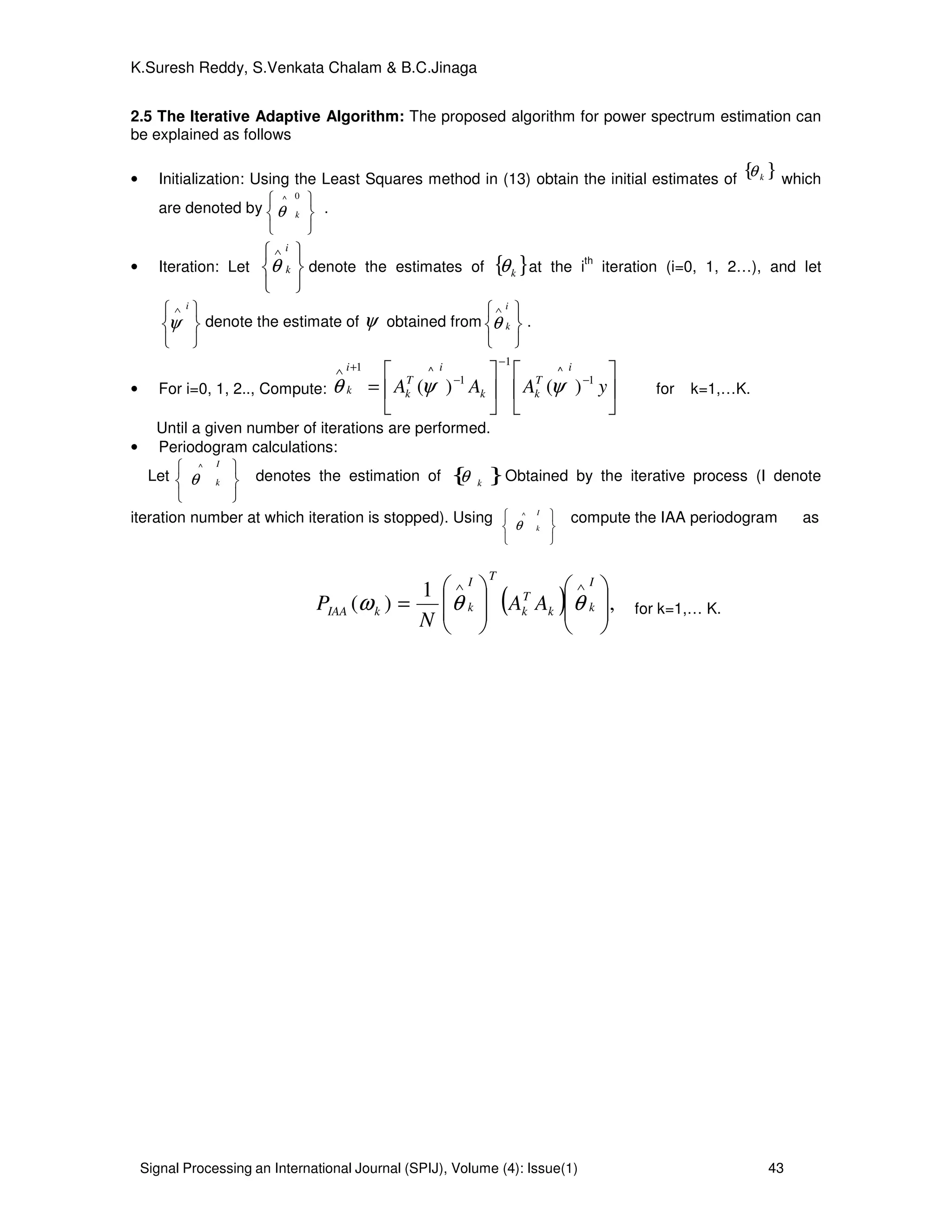
![Signal Processing an International Journal (SPIJ), Volume (4): Issue(1) 44
K.Suresh Reddy, S.Venkata Chalam & B.C.Jinaga
3. PROPOSED SYSTEM AND SIMULATED DATA:
The system model for the proposed algorithm is shown in Figure 1.
FIGURE 1: Proposed system model for the simulated data.
The system model for the proposed algorithm is shown in Figure 1. We consider a data
sequence consisting of M=3 sinusoidal components with frequencies 0.1, 0.4 and 0.41 Hz, and
amplitudes 2,4 and 5, respectively. The phases of the three sinusoids are independently and
uniformly distributed over [ ]π2,0 and the additive noise is white normally distributed with mean
of 0 and variance of
2
σ =0.01. We define the signal-to-noise ratio (SNR) of each sinusoid as
= 2
2
10
2/
log10
σ
αm
mSNR dB m=1,2,3. (25)
Where mα is the amplitude of the m
th
sinusoidal component hence SNR1=23 dB, SNR2=29 dB and
SNR3= 31 dB in this simulation example. The input data sequence for the system model is as
follows
)()4.02cos(4)4.02cos(3)1.02cos(2)( twttttx +++= πππ (26)
Where )(tw zero mean Gaussian is distributed white noise with variance of 0.01 and the sampling
pattern follows a Poisson process with parameter
1
1.0 −
= sλ , that is, the sampling intervals are
exponentially distributed with mean 10
1
==
λ
µ s. We choose N=64 and show the sampling pattern
in Fig. 3(a). Note the highly irregular sampling intervals, which range from 0.2 to 51.2 s with mean
value 9.3 s. Fig. 3(b) shows the spectral window corresponding to Fig. 3(a). The smallest frequency
at which the spectral 00 〉f at which the spectral window has a peak close to
2
N is approximately
10 Hz. Hence 2/0max ff = =5Hz. The step f∆ of the frequency grid is chosen as 0.005 Hz. However,
they are most suitable for data sequences with discrete spectra (i.e., sinusoidal data), which is the
case we emphasize in this paper. Of the existing methods for nonuniform sinusoidal data, Welch,
MUSIC and ESPRIT methods appear to be the closest in spirit to the IAA.
AR (P)
Filter
Periodogram
Analysis
Input data
x (n)
White
Noise w (n)
Periodogram
Using IAA
Periodogram
Using LSP
Y(n)
Non Parametric Spectrum
Pxx
(ω)
PIAA
(ω)
PLS ω)
+](https://image.slidesharecdn.com/spij-67-160221145823/75/A-New-Enhanced-Method-of-Non-Parametric-power-spectrum-Estimation-7-2048.jpg)

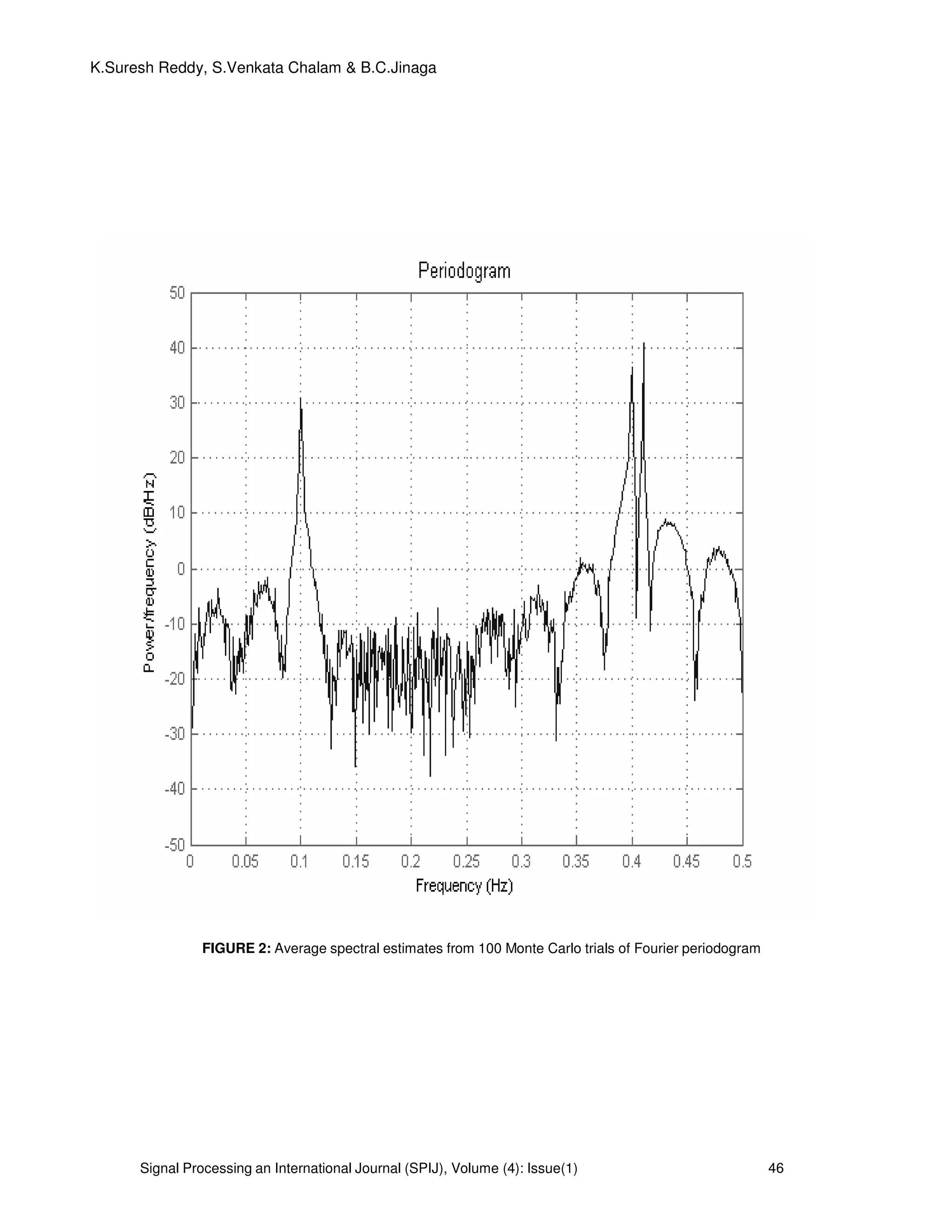
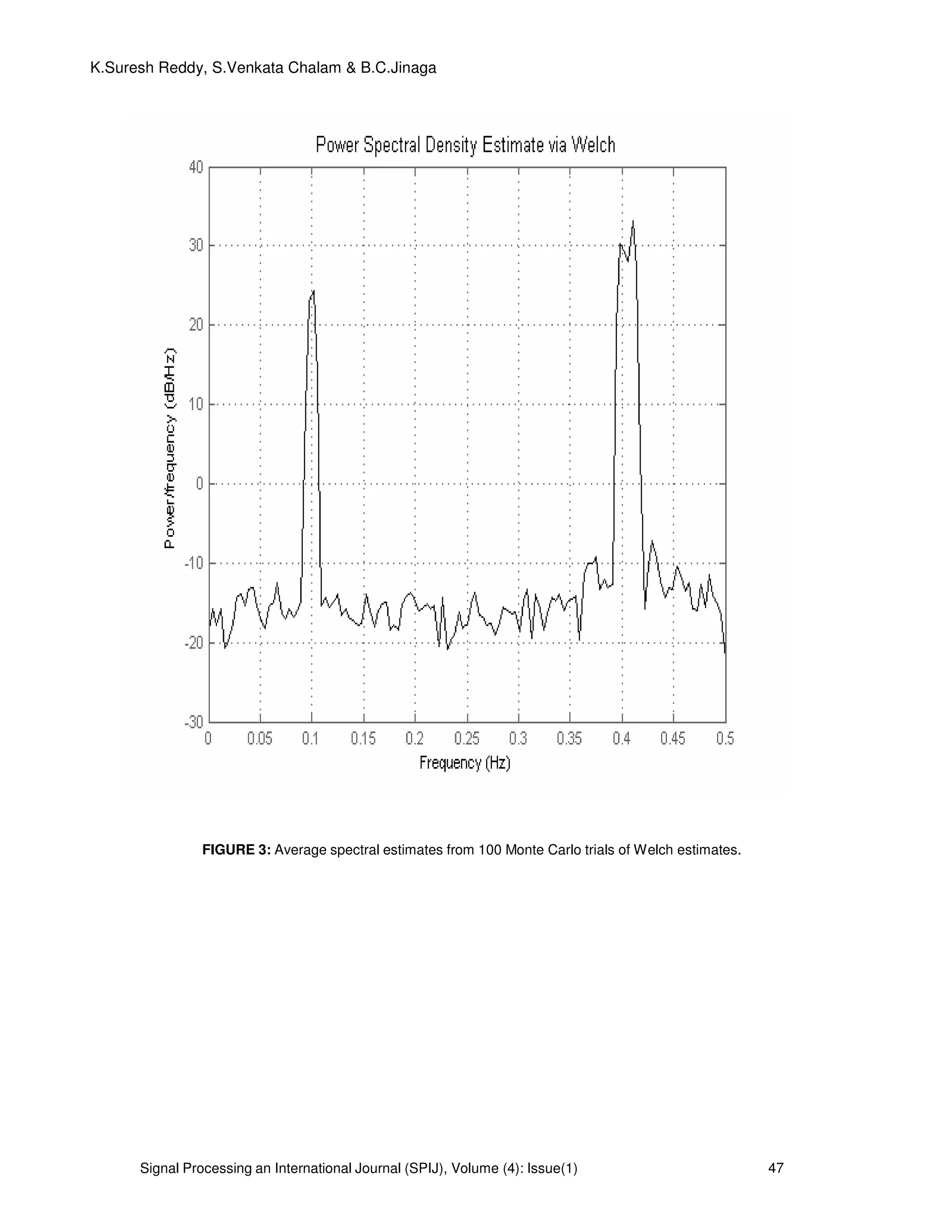
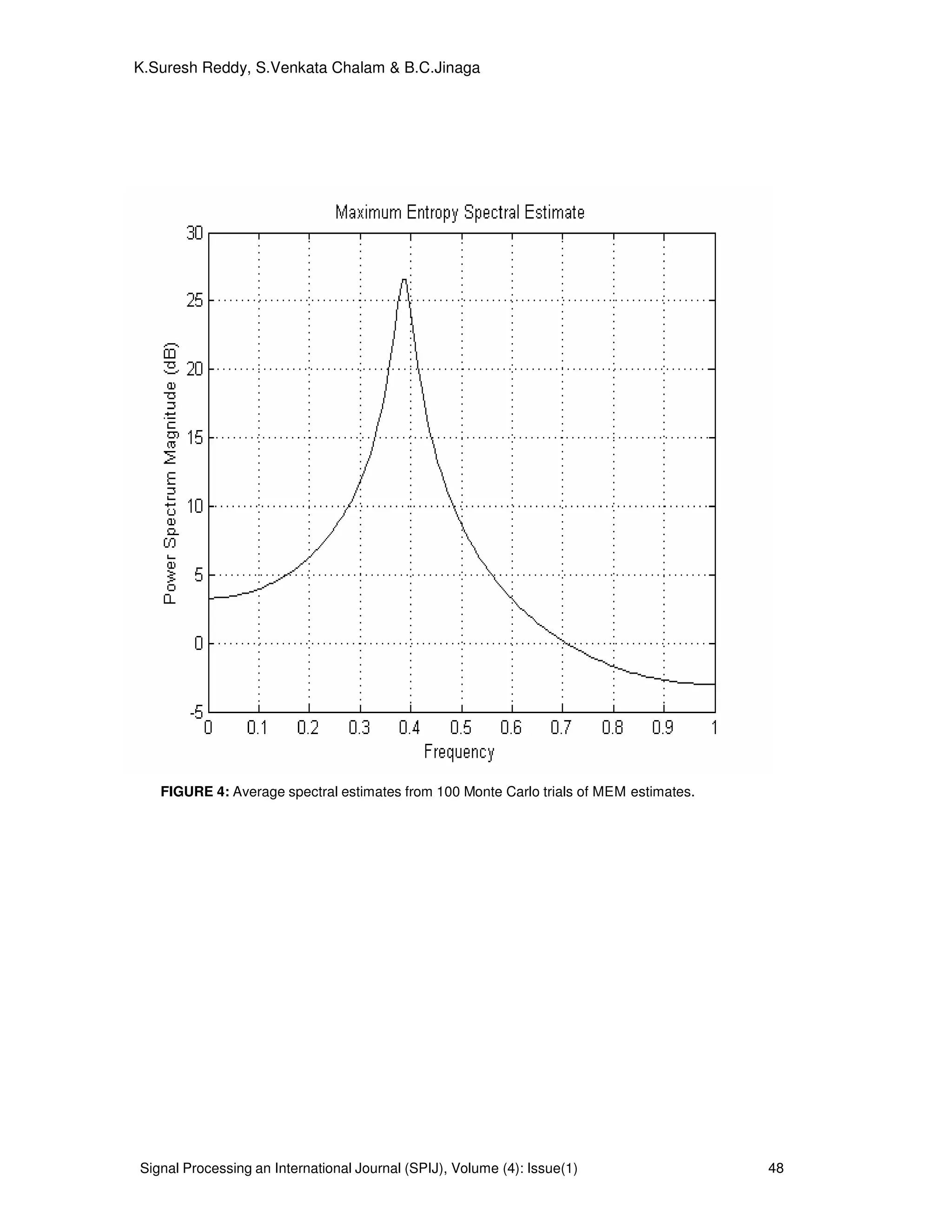
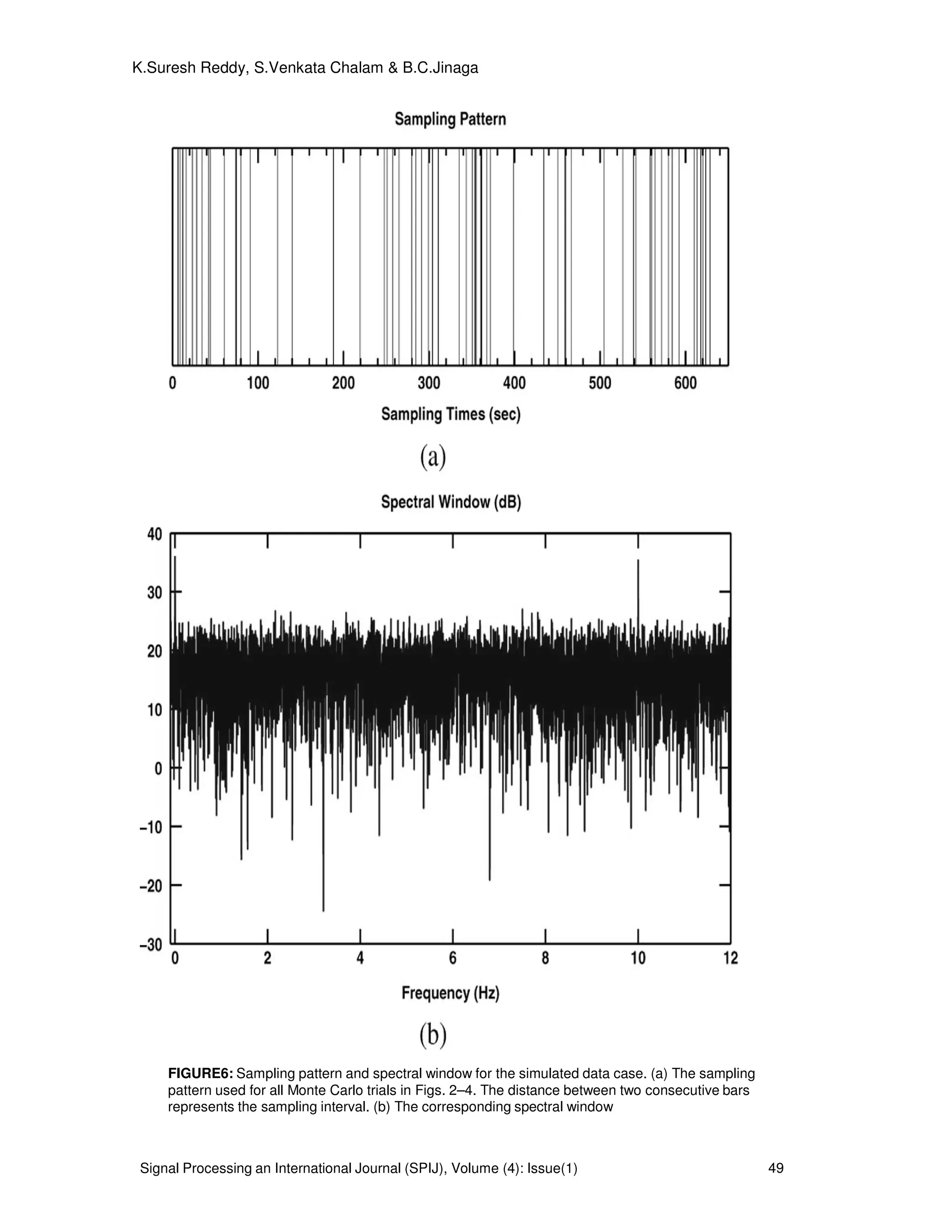

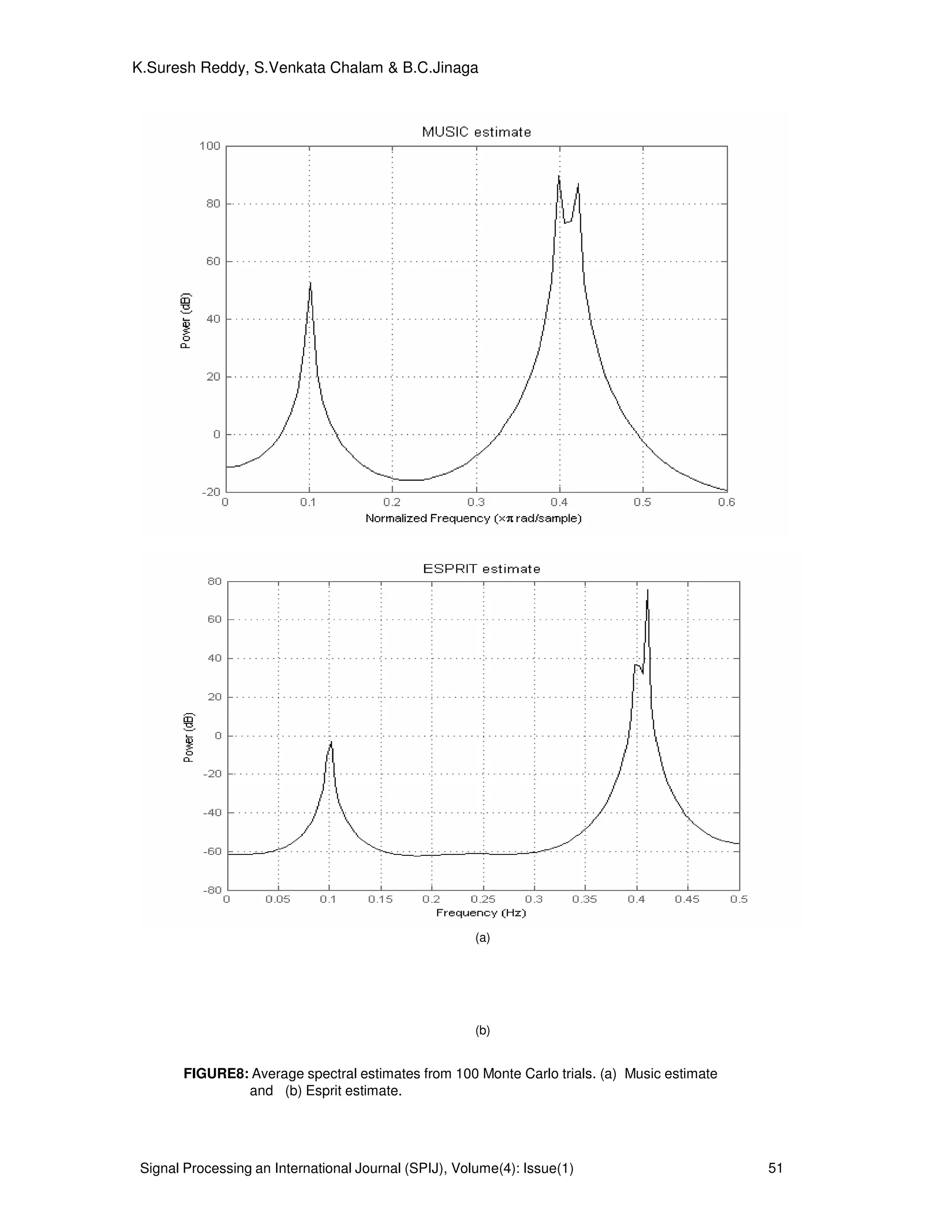
![Signal Processing an International Journal (SPIJ), Volume(4): Issue(1) 52
K.Suresh Reddy, S.Venkata Chalam & B.C.Jinaga
FIGURE9: Average spectral estimates from 100 Monte Carlo trials of Lomb
periodogram.
. 4. CONSLUSIONS:
Of the existing methods for nonuniform sinusoidal data, the MUSIC and ESPRIT
methods appear to be the closest in spirit to the IAA proposed here (see the cited paper for
explanations of the acronyms used to designate these methods). Indeed, all these methods
make use of the estimated covariance matrix that is computed in the first iteration IAA from
LSP. In fact Welch (when used with the same covariance matrix dimension as IAA) is
essentially identical to the first iteration of IAA. MUSIC and ESPRIT.In the case of a single
sinusoidal signal in white Gaussian noise, the LSP is equivalent to the method of
maximum likelihood and therefore it is asymptotically statistically efficient. Consequently, in
this case LSP can be expected to outperform IAA. In numerical computations we have
observed that LSP tends to be somewhat better than IAA for relatively large values of N or
SNR; however, we have also observed that, even under these conditions that are ideal for
LSP, the performance of IAA in terms of MSE (mean squared error) is slightly better (by a
fraction of a dB) than that of LSP when or SNR becomes smaller than a certain threshold.
5. REFERENCES
[1] Stoica,P and R.L. Moses, Introduction to Spectral Analysis, Prentice-Hall, 1997, pp. 24-26.
[2] Welch, P.D, "The Use of Fast Fourier Transform for the Estimation of Power Spectra: A
Method Based on Time Averaging Over Short, Modified Periodogram," IEEE Trans.
Audio electro acoustics, Vol. AU-15 (June 1967), pp. 70-73.
[3] Oppenheim, A.V., and R.W. Schafer, Discrete-Time Signal Processing, Prentice-Hall,
1989, pp. 730-
742.
[4] B. Priestley, Spectral Analysis and Time Series, Volume 1: Univariate Series, New York:
Academic, 1981.
[5] P. Stoica and R. L. Moses, Spectral Analysis of Signals Upper Saddle River,
NJ: Prentice-Hall, 2005.
[6] F.J.M.Barning,“The numerical analysis of the light-curve of12 lacerate,” Bull.](https://image.slidesharecdn.com/spij-67-160221145823/75/A-New-Enhanced-Method-of-Non-Parametric-power-spectrum-Estimation-15-2048.jpg)
![Signal Processing an International Journal (SPIJ), Volume(4): Issue(1) 53
K.Suresh Reddy, S.Venkata Chalam & B.C.Jinaga
Astronomy. Inst Netherlands, vol. 17, no. 1, pp. 22–28, Aug. 1963.
[7] P. Vanicek, “Approximate spectral analysis by least-squares fit,” Astro- phys. Space Sci.,
vol. 4, no. 4, pp. 387–391, Aug. 1969.
[8] P. Vanicek, “Further development and properties of the spectral anal- ysis by
least- squares,” Astrophys. Space Sci.vol. 12, no. 1, pp. 10–33, Jul. 1971.
[9]N. R. Lomb, “Least-squares frequency analysis of unequally spaced data,” Astrophysics
. Space Sci., vol. 39, no. 2, pp. 447–462, Feb. 1976.
[10] S. Ferraz-Mello, “Estimation of periods from unequally spaced obser- vations,”
Astronom. J., vol.86, no.4, pp. 619–624, Apr.
1981.
[11] J. D. Scargle, “Studies in astronomical time series analysis. II—Statis- tical aspects of
spectral analysis of unevenly spaced data,” Astrophys. J., vol. 263, pp 835–853,
Dec.
1982.
[12] W. H. Press and G. B. Rybicki, “Fast algorithm for spectral analysis of unevenly
sampled data,” Astrophys. J., vol. 338, pp. 277–280, Mar.1989.
[13] J. A. Fessler and B. P. Sutton, “Nonuniform fast Fourier transforms using min-max
interpolation,” IEEE Trans. Signal Process., vol. 51, no. 2, pp. 560–574, Feb.
2003.
[14] N. Nguyen and Q. Liu, “The regular Fourier matrices and nonuniform fast
Fourier transforms,” SIAM J. Sci. Comput., vol. 21, no. 1,pp. 283–293, 2000.
[15] L. Eyer and P. Bartholdi, “Variable stars: Which Nyquist frequency?,”Astron. Astrophys.
Supp Series, vol. 135, pp. 1–3, Feb. 1999.
[16] F. A. M. Frescura, C. A. Engelbrecht, and B. S. Frank, “Significance tests for
periodogram peaks,” NASA Astrophysics Data System, Jun. 2007
[17] P. Reegen, “SigSpec—I. Frequency- and phase resolved significance in Fourier space,”
Astron Astrophys., vol. 467, pp. 1353–1371, Mar.2007.
[18] J. Li and P. Stoica, “An adaptive filtering approach to spectral estimation and SAR
imaging,”Trans., vol. 44, no. 6,pp. 1469–1484, Jun. 1996.
[19] T. Yardibi, M. Xue, J. Li, P. Stoica, and A. B.Baggeroer, “Iterative adaptive approach for
sparse signal representation with sensing applications,” IEEE Trans. Aerosp. Electron
. Syst., 2007.
[20] P. Stoica and Y. Selen, “Model-order selection: A review of information criterion rules,”
IEEE Signal Process. Mag., vol. 21, no. 4, pp.36–47, Jul. 2004.
[21] E. S. Saunders, T. Naylor, and A. Allan, “Optimal placement of a limited number of
observations for period searches,” Astron. Astrophys.,vol. 455, pp. 757–763, May 2006.](https://image.slidesharecdn.com/spij-67-160221145823/75/A-New-Enhanced-Method-of-Non-Parametric-power-spectrum-Estimation-16-2048.jpg)